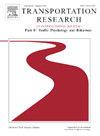Two-stage transition procedure reduces potential hazards on planned transitions in automated driving
IF 3.5
2区 工程技术
Q1 PSYCHOLOGY, APPLIED
Transportation Research Part F-Traffic Psychology and Behaviour
Pub Date : 2024-10-28
DOI:10.1016/j.trf.2024.10.017
引用次数: 0
Abstract
The feasibility of human-system transition in conditional automated driving systems remains an unresolved issue. These advanced systems necessitate support for planned transitions due to their frequent occurrence. Concerns in planned transitions include the lack of situation awareness and physical preparedness; specifically, drivers lack awareness of the traffic situation and their hands are occupied at the moment of transition. In this study, three types of two-stage transition procedures were investigated as potential solutions to these issues. In these procedures, the takeover request was issued after either a prenotification alert (notifying drivers of an impending takeover request) or a preparation request for takeover (requiring drivers to cease non-driving-related activities and monitor the traffic situation with both hands unoccupied for approximately 1 min before the transition). The effectiveness of combining road signs with the preparation request to facilitate takeover was also evaluated. The results indicate that a two-stage transition procedure incorporating a preparation request can mitigate potential hazards in planned transitions. This procedure resulted in shorter takeover reaction times and a lower rate of lane change failures post-takeover compared to the single-stage transition procedure. The addition of road signs to the preparation request further enhanced takeover support. However, the two-stage transition procedure was ineffective when only a prenotification alert was provided without a preparation request. Furthermore, the gaze behaviour of the drivers during the preparation period suggested the development of situation awareness for a safe and smooth takeover. The trend in gaze behaviour shifted from “busy and widespread” to “stably and centralised,” occurring within approximately 20 s. These findings may contribute to the design of automated driving systems, the planning of road infrastructures, and the development of driver monitoring systems.
两阶段过渡程序可减少自动驾驶计划过渡时的潜在危险
在有条件的自动驾驶系统中,人-系统转换的可行性仍是一个悬而未决的问题。由于这些先进系统经常出现有计划的转换,因此有必要为其提供支持。计划过渡中存在的问题包括缺乏情况意识和身体准备;具体而言,驾驶员缺乏对交通情况的意识,并且在过渡时双手被占用。本研究调查了三种两阶段过渡程序,作为解决这些问题的潜在方案。在这些程序中,接管请求是在预先通知提醒(通知驾驶员接管请求即将到来)或接管准备请求(要求驾驶员停止与驾驶无关的活动,并在过渡前约 1 分钟双手空闲时监控交通状况)之后发出的。此外,还评估了将道路标志与准备要求相结合以促进接管的效果。结果表明,包含准备请求的两阶段过渡程序可以减轻计划过渡中的潜在危险。与单阶段过渡程序相比,该程序可缩短接管反应时间,降低接管后变道失败率。在准备请求中添加路标进一步增强了接管支持。但是,如果只提供预通知提醒而不提供准备请求,两阶段转换程序则不起作用。此外,驾驶员在准备期间的注视行为表明,他们已经形成了安全顺利接管的情况意识。这些发现可能有助于自动驾驶系统的设计、道路基础设施的规划以及驾驶员监控系统的开发。
本文章由计算机程序翻译,如有差异,请以英文原文为准。
求助全文
约1分钟内获得全文
求助全文
来源期刊
CiteScore
7.60
自引率
14.60%
发文量
239
审稿时长
71 days
期刊介绍:
Transportation Research Part F: Traffic Psychology and Behaviour focuses on the behavioural and psychological aspects of traffic and transport. The aim of the journal is to enhance theory development, improve the quality of empirical studies and to stimulate the application of research findings in practice. TRF provides a focus and a means of communication for the considerable amount of research activities that are now being carried out in this field. The journal provides a forum for transportation researchers, psychologists, ergonomists, engineers and policy-makers with an interest in traffic and transport psychology.

 求助内容:
求助内容: 应助结果提醒方式:
应助结果提醒方式:


